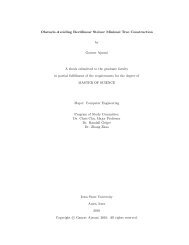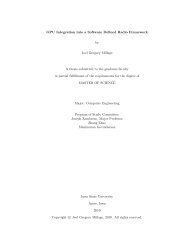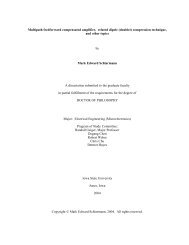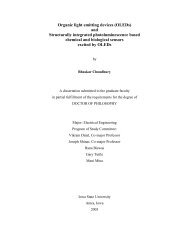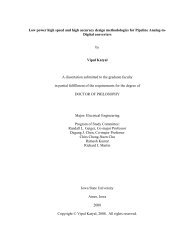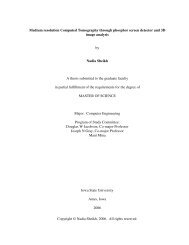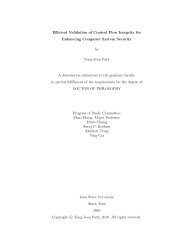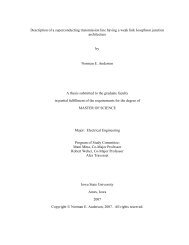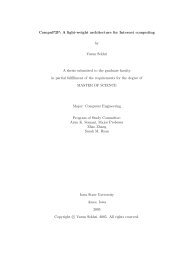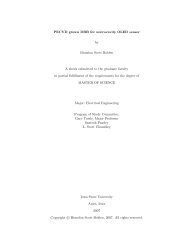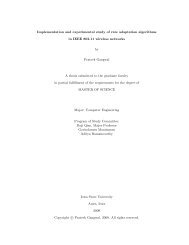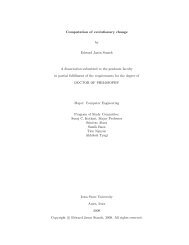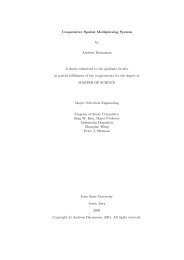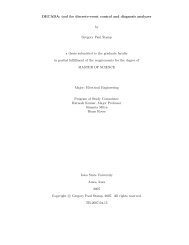Characterization of polycrystalline silicon films grown by LPCVD of ...
Characterization of polycrystalline silicon films grown by LPCVD of ...
Characterization of polycrystalline silicon films grown by LPCVD of ...
Create successful ePaper yourself
Turn your PDF publications into a flip-book with our unique Google optimized e-Paper software.
<strong>Characterization</strong> <strong>of</strong> <strong>polycrystalline</strong> <strong>silicon</strong> <strong>films</strong><br />
<strong>grown</strong> <strong>by</strong> <strong>LPCVD</strong> <strong>of</strong> silane<br />
<strong>by</strong><br />
Justin Bradley Dorhout<br />
A thesis submitted to the graduate faculty<br />
in partial fulfillment <strong>of</strong> the requirements for the degree <strong>of</strong><br />
MASTER OF SCIENCE<br />
Major: Electrical Engineering<br />
Program <strong>of</strong> Study Committee:<br />
Gary Tuttle (Major Pr<strong>of</strong>essor)<br />
Vikram Dalal<br />
Rana Biswas<br />
Iowa State University<br />
Ames, Iowa<br />
2006
ii<br />
Graduate College<br />
Iowa State University<br />
This is to certify that the master’s thesis <strong>of</strong><br />
Justin Bradley Dorhout<br />
has met the thesis requirements <strong>of</strong> Iowa State University<br />
___________________________________<br />
Major Pr<strong>of</strong>essor<br />
___________________________________<br />
For the Major Program
iii<br />
To my parents,<br />
with love and gratitude.
iv<br />
Table <strong>of</strong> Contents<br />
Abstract vi<br />
Chapter 1: Introduction 1<br />
1.1 Historical Perspective 1<br />
1.2 Motivation and Objective 1<br />
Chapter 2: Fundamentals <strong>of</strong> <strong>LPCVD</strong> 3<br />
2.1 Chemical Source 3<br />
2.2 Reactor Type 3<br />
2.3 Reaction Chemistry and Kinetics 4<br />
2.4 Reactor Description 5<br />
2.5 Deposition Procedure 8<br />
2.6 Phosphorus Diffusion 10<br />
Chapter 3: <strong>Characterization</strong> Techniques 11<br />
3.1 Thickness Measurements 11<br />
3.1.1 Nanometrics Model 210 NanoSpec® 11<br />
3.1.2 UV/VIS/NIR Reflectance 11<br />
3.2 Optical Band Gap 13<br />
3.3 Raman Spectroscopy 14<br />
3.4 X-ray Crystallography 16<br />
3.5 Resistivity 18
Chapter 4: Results and Discussion 21<br />
v<br />
4.1 Deposition Rate Trends 21<br />
4.2 Band Gap Results 23<br />
4.2.1 Effect <strong>of</strong> Deposition Temperature 24<br />
4.2.2 Effect <strong>of</strong> Crystalline Fraction 25<br />
4.2.3 Effect <strong>of</strong> Pressure 26<br />
4.3 Raman Analysis 26<br />
4.4 X-Ray Diffraction Analysis 28<br />
4.5 Resistivity Trends 30<br />
Chapter 5: Conclusions 33<br />
5.1 Film growth 33<br />
5.2 Optical Properties 33<br />
5.3 Crystallinity and Morphology 34<br />
5.4 Resistivity 34<br />
5.5 Future work 34<br />
References 35<br />
Acknowledgements 39<br />
Appendix: <strong>LPCVD</strong> Standard Operating Procedures 40
vi<br />
Abstract<br />
Deposition <strong>of</strong> <strong>polycrystalline</strong> <strong>silicon</strong> <strong>by</strong> thermolysis <strong>of</strong> silane, SiH4, is a common<br />
technique for creating poly<strong>silicon</strong> <strong>films</strong> for a variety <strong>of</strong> applications. The deposition<br />
temperature and pressure greatly influence parameters relating to growth rate and film<br />
quality. These characteristics include film crystallinity and resulting grain orientation that<br />
determine the optical and electrical properties <strong>of</strong> the <strong>films</strong> and their suitability for particular<br />
applications. An empirical approach was taken to characterize the growth process and<br />
resulting film quality. Polycrystalline <strong>silicon</strong> <strong>films</strong> were <strong>grown</strong> to map a region <strong>of</strong><br />
temperatures and pressures in the range <strong>of</strong> 575 o C to 700 o C and 200 mTorr to 500 mTorr.<br />
Deposition rate increased with increasing pressure, and was a strong function <strong>of</strong> temperature,<br />
increasing quickly then diminishing due to silane depletion. The crystallinity <strong>of</strong> <strong>films</strong><br />
increased with temperature and decreased with pressure, exhibiting regions <strong>of</strong> rapid transition<br />
between amorphous and crystalline phases. X-ray diffraction was used to determine grain<br />
orientation and size. The grains showed preferential growth while and <br />
grains were completely inhibited at low temperatures. Band gap energy decreased with<br />
increasing temperature and crystallinity. Resistivity <strong>of</strong> as-deposited, intrinsic <strong>films</strong> was very<br />
high. However, planar source phosphorus diffusion and annealing reduced resistivity to as<br />
low as 2.5·10 -3 Ω·cm.
1.1 Historical Perspective<br />
1<br />
Chapter 1: Introduction<br />
For several decades, thermolysis <strong>of</strong> silane through low-pressure chemical vapor<br />
deposition (<strong>LPCVD</strong>) has been utilized in the fabrication <strong>of</strong> MOSFET gate electrodes as well<br />
as load resistors in integrated circuits [1]. Polycrystalline <strong>silicon</strong> (poly<strong>silicon</strong>) has also<br />
demonstrated properties desirable in the making <strong>of</strong> EEPROM memories and thin-film<br />
transistors [2], most <strong>of</strong>ten arrayed to drive display elements. Moreover, poly<strong>silicon</strong> <strong>films</strong><br />
produced <strong>by</strong> means <strong>of</strong> low-pressure chemical vapor deposition were applied toward the<br />
fabrication <strong>of</strong> thin film solar cells although innovation <strong>of</strong> alternate techniques such as<br />
plasma-enhanced CVD and hot-wire CVD have diminished the market share <strong>of</strong> poly<strong>silicon</strong><br />
due to the thermal economy <strong>of</strong> these techniques [3].<br />
Poly<strong>silicon</strong> has now been used extensively in the nascent field <strong>of</strong> micro- and nano-<br />
electromechanical devices; certainly in part owing to the vast body <strong>of</strong> work and knowledge<br />
developed for microelectronic research and the existing infrastructure.<br />
1.2 Motivation and Objective<br />
Given the volume <strong>of</strong> research available describing the many properties <strong>of</strong> poly<strong>silicon</strong>,<br />
this work was undertaken to characterize and understand a particular <strong>LPCVD</strong> system to the<br />
end that <strong>polycrystalline</strong> <strong>silicon</strong> <strong>films</strong> may be deposited with relative control over film<br />
properties such as thickness, resistivity, crystalline volume, grain orientation, and optical<br />
behavior[4]. While physical constants relating to the use <strong>of</strong> silane in <strong>LPCVD</strong> applications<br />
are known in detail, the behavior <strong>of</strong> a particular <strong>LPCVD</strong> system is a mixture <strong>of</strong> a number <strong>of</strong><br />
variables. These variables include effects such as substrate temperature gradients and gas-
source depletion [5]. Therefore, while previous research is invaluable in learning the<br />
principles <strong>of</strong> <strong>LPCVD</strong> and regime <strong>of</strong> operation, an empirical approach best suits the<br />
2<br />
optimization <strong>of</strong> a particular system. This work is largely motivated toward produce a tool for<br />
use in the synthesis <strong>of</strong> future research.
3<br />
Chapter 2: Fundamentals <strong>of</strong> Low-Pressure Chemical Vapor Deposition<br />
2.1 Chemical Source<br />
Polycrystalline <strong>silicon</strong> (poly<strong>silicon</strong>) is generally deposited <strong>by</strong> chemical vapor<br />
deposition utilizing thermolysis <strong>of</strong> silane, SiH4. Silane may be reacted to form <strong>silicon</strong> <strong>films</strong><br />
over a great range <strong>of</strong> pressure and temperatures, including atmospheric pressure if in the<br />
presence <strong>of</strong> a carrier gas (H2, N2, He), to the exclusion <strong>of</strong> oxygen [5].<br />
2.2 Reactor Type<br />
The deposition system utilized in these growths is a “hot-wall” low-pressure chemical<br />
vapor system operating on the principle <strong>of</strong> heating pure silane to high temperatures at<br />
pressures on the order <strong>of</strong> a few hundred mTorr. Low pressure benefits the deposition in two<br />
ways. First, the vacuum created in the chamber limits the presence <strong>of</strong> oxygen. Silane is<br />
pyrophoric and combusts in the presence <strong>of</strong> oxygen at room temperature. Additionally, it is<br />
desirable to limit the amount <strong>of</strong> oxygen in the reactor as SiO2 will be incorporated into the<br />
film and lower the quality and crystallinity [6].<br />
The second advantage <strong>of</strong> operating a reactor in a low-pressure regime are the kinetics<br />
<strong>of</strong> the decomposition and deposition <strong>of</strong> silane. At lower pressures, the mean free path <strong>of</strong><br />
silane molecules is increased. The molecule will undergo fewer collisions so that gas-phase<br />
reactions are reduced. Moreover, as the reactive species diffuse through the boundary layer<br />
and absorb onto the substrate surface, they will diffuse until they desorb or incorporate into a<br />
low energy bonding arrangement. The longer the diffusion length <strong>of</strong> the species, the more<br />
ordered the film will become. However, should two or more diffusing species with relatively
low kinetic energy collide and bond, they could begin the nucleation <strong>of</strong> another grain and<br />
4<br />
lower the crystallinity <strong>of</strong> the film. Therefore, lowering the population <strong>of</strong> diffusing species on<br />
the surface <strong>of</strong> the film will increase the crystallinity <strong>of</strong> the deposited film. The surface<br />
species population is determined <strong>by</strong> the rate <strong>of</strong> arrival, which is related to the partial pressure<br />
[7]. Hence, lower chamber pressure translates into higher crystallinity at a given<br />
temperature.<br />
2.3 Reaction Chemistry and Kinetics<br />
Very simply, one mole SiH4 decomposes into one mole Si and two moles H2.<br />
SiH Si+<br />
2H<br />
4<br />
→ (2.1)<br />
The kinetics <strong>of</strong> the reaction are considerably more complicated however, and a full<br />
treatment will not be provided here [8]. It is thought that silane-based reactions are<br />
dominated at the surface <strong>by</strong> silane and silylene (SiH2), and less <strong>of</strong>ten <strong>by</strong> silyl (SiH3).<br />
The reaction rate is usually limited <strong>by</strong> one <strong>of</strong> two factors: the arrival rate <strong>of</strong> reactive<br />
species or the rate at which the reaction will occur at a given temperature. These are<br />
typically referred to as mass-transport limited reaction and surface-rate limited reactions.<br />
The surface-reaction rate is a strong function <strong>of</strong> temperature, and follows an Arrhenius<br />
relation which increases exponentially with temperature [5].<br />
2<br />
⎛ − Ea<br />
⎞<br />
surface rate ∝ exp ⎜ ⎟ (2.2)<br />
⎝ kT ⎠<br />
For silane, Ea is reported between 1.6 eV – 2.0 eV. A small deviation in temperature<br />
results in a sizable change in reaction rate. The mass-transport rate has a slight positive
5<br />
correlation with temperature but is mostly determined <strong>by</strong> the partial pressure <strong>of</strong> silane at the<br />
reaction location and will generally increase linearly with pressure. At higher temperatures<br />
<strong>LPCVD</strong> reactors operate exclusively in mass-transport rate limited regime, at lower<br />
temperatures operation is confined to the surface-rate limited regime. This effect is<br />
illustrated in Fig. 2.1.<br />
Figure 2.1 Temperature dependence <strong>of</strong> <strong>silicon</strong> epitaxial growth for four different sources. The growth<br />
rate is surface-reaction limited in region A and is mass-transport-limited in region B [3].<br />
2.4 Reactor Description<br />
In this work, growth <strong>of</strong> poly<strong>silicon</strong> <strong>by</strong> <strong>LPCVD</strong> <strong>of</strong> silane was performed in a<br />
horizontal furnace reactor chamber. The Lindburg Sola Basic furnace features three
6<br />
independent zone-controllers. The furnace is four feet in length. The hot zone <strong>of</strong> the furnace<br />
is three feet in length, beginning 6 inches into the furnace on both ends. The horizontal<br />
cylindrical axis <strong>of</strong> the furnace can accommodate quartz tubes <strong>of</strong> 8 inches in diameter<br />
however the quartz tube utilized in this system is 6 inches in diameter and five feet in length.<br />
The loading side <strong>of</strong> the furnace tube is sealed <strong>by</strong> means <strong>of</strong> a pressure differential between<br />
atmosphere and the reactor chamber. The cap assembly consists <strong>of</strong> a gasket and seal plate<br />
mounted concentrically around a quartz plug 7 inches in diameter extending approximately<br />
1.5 feet into the furnace tube. Figure 2.2 shows the basic design <strong>of</strong> the system.<br />
Figure 2.2 Schematic Diagram <strong>of</strong> <strong>LPCVD</strong> reactor<br />
At the opposite end <strong>of</strong> the furnace tube, the vacuum tube tapers down to a quartz<br />
cylinder 1.5 inches in diameter. This cylinder extends beyond the body <strong>of</strong> the furnace tube<br />
where it is then coupled with a vacuum line. Below this vacuum port, a thermocouple well is<br />
fused into the furnace. The thermocouple well is a tube slightly under 3 feet in length and 2
cm in diameter. The thermocouple well protrudes into the interior <strong>of</strong> the vacuum chamber<br />
7<br />
and ends in close proximity the end plug. The thermocouple well accommodates five type-R<br />
thermocouples embedded in a ceramic material that is capable <strong>of</strong> providing electrical<br />
insulation for the leads at high temperatures. A Keithley 740 scanning system thermometer<br />
is connected to a type-R thermocouple and correlates the voltage across the thermocouple to<br />
junction temperature and in turn outputs this value on its front display.<br />
The vacuum system components existing outside the furnace chamber include an<br />
Alcatel vacuum pump, a pump inlet trap, a MKS type 252A exhaust valve controller, a<br />
Hastings thermocouple vacuum gauge, and an MKS Baritron vacuum gauge system.<br />
The vacuum pump is connected to the vacuum chamber via the particulate trap and a<br />
steel vacuum tube. A line delivering dry N2 to the pump is connected via the pump’s exhaust<br />
manifold. The purpose <strong>of</strong> this nitrogen gas line is to dilute the pump’s exhaust and also<br />
prevent silane gas from accumulating in the pump. The exhaust valve is incorporated into<br />
the main line, between the Hastings and Baritron vacuum transducers. The Baritron<br />
transducer is on the side <strong>of</strong> the reactor chamber while the Hastings T.C. transducer is on the<br />
side <strong>of</strong> the pump relative to the exhaust valve.<br />
The Baritron vacuum gauge is interfaced with a MKS PDR-C-1B unit which<br />
correlates the voltage output <strong>of</strong> the transducer to the system pressure at the Baritron gauge.<br />
This output pressure is displayed on the front <strong>of</strong> the MKS unit. Additionally, the voltage<br />
output <strong>of</strong> the Baritron transducer is also provided to an MKS pressure controller unit. This<br />
unit is connected to the exhaust throttle and regulates system pressure at a desired value<br />
during a <strong>LPCVD</strong> growth.<br />
The Hastings thermocouple pressure transducer indicates the pressure near the pump
inlet. For reliable operation, this pressure value must always be lower than that <strong>of</strong> the<br />
Baritron gauge while SiH4 is sourced to the chamber. Or rather, when the exhaust value is<br />
8<br />
fully opened, the pressure indicated <strong>by</strong> the Hastings gauge at a given flowrate determines the<br />
minimum deposition pressure at that particular flowrate. The typical system baseline<br />
pressure is approximately 65 mTorr.<br />
Silane and nitrogen are available to the reactor chamber via a gas line that is<br />
connected to the front, or loading end <strong>of</strong> the furnace. A master gas control enables two Tylan<br />
260 mass flow controllers, one each for nitrogen and silane.<br />
Within the reactor chamber a quartz runner approximately 3 feet long rests as far back<br />
inside the furnace as possible. A quartz boat which serves as a sample platform in all<br />
experiments is supported <strong>by</strong> the runner. When under vacuum the boat rests in position<br />
slightly above the thermocouple well.<br />
2.5 Deposition Procedure<br />
Polycrystalline <strong>silicon</strong> <strong>films</strong> were deposited on two types <strong>of</strong> substrates for this work.<br />
The first type <strong>of</strong> substrate employed was commercially available Corning 7059 glass<br />
samples. The second type <strong>of</strong> substrate was (100) crystalline <strong>silicon</strong> wafers covered with a<br />
100 nm thick thermally-<strong>grown</strong> dry oxide. Both types <strong>of</strong> substrates were subjected to the<br />
RCA or “standard” clean prior to their introduction to the reactor chamber. The RCA clean<br />
consists <strong>of</strong> immersion in a 1:1:5 NH4OH:H2O2:H2O solution heated to 80 °C for fifteen<br />
minutes, rinsing, a brief immersion in 50:1 diluted HF, subsequent rinse, and finally an<br />
immersion in a 1:1:6 HCl:H2O2:H2O at 80 °C. The samples were removed, rinsed, and dried.<br />
The <strong>LPCVD</strong> reactor was brought up to atmospheric pressure so that samples could be
loaded. In doing this, the exhaust throttle valve control was set to the completely closed<br />
9<br />
position and 200 sccm <strong>of</strong> N2 was directed into the reactor chamber. After approximately one<br />
minute the pressure within the chamber reached atmosphere and the cap was removed.<br />
Using a push-rod, the runner was partially drawn out <strong>of</strong> the furnace tube to allow for<br />
substrate loading. Silicon wafers were mounted vertically in a quartz boat with the polished<br />
surface facing the gas stream source. Glass substrates bend and warp at temperatures used<br />
during these growths, and therefore, were required to lay flat on a <strong>silicon</strong> wafer which was<br />
placed across the boat. The boat and runner were then brought back into position, locating<br />
the substrate approximately in the center <strong>of</strong> the furnace hot zone.<br />
The end cap was replaced and the exhaust valve was opened so that the system could<br />
once again pump down to low-pressure. The growth temperature was selected <strong>by</strong> setting the<br />
three furnace controls to the desired value. Temperature ramp-up required about 20 minutes.<br />
Prior to deposition, the system was once again purged with 20 sccm nitrogen. Silane<br />
was then sourced to the reactor chamber <strong>by</strong> way <strong>of</strong> a mass flow controller. Silane flow rates<br />
were in the range 25-35 sccm throughout this series <strong>of</strong> experiments. Simultaneously with the<br />
sourcing <strong>of</strong> silane, chamber pressure was regulated to the desired value via the exhaust<br />
throttle control. Selected deposition pressures were varied in the range <strong>of</strong> 200-500 mTorr.<br />
Once the growth was completed, the silane source was closed and the exhaust throttle fully<br />
opened. The system returned to its baseline pressure. The system was then purged finally<br />
with nitrogen for five minutes. The exhaust throttle was set to closed, and the reactor was<br />
brought up to atmospheric pressure. The end cap was removed and the samples are removed.
2.6 Phosphorus Diffusion<br />
10<br />
Various samples were doped with phosphorus to modify electrical characteristics <strong>of</strong><br />
the poly<strong>silicon</strong> [9]. Phosphorus was not <strong>grown</strong> into the <strong>films</strong> in situ, but rather was diffused<br />
into the <strong>films</strong> using planar source wafers. The planar diffusion sources used were<br />
commercially available PH-950 type manufactured <strong>by</strong> Saint Gobain ceramics. The source<br />
wafers were entirely composed <strong>of</strong> <strong>silicon</strong> pyrophosphate, SiP2O7. When heated to diffusion<br />
temperatures P2O5 vaporizes from the source. This vapor deposits on the poly<strong>silicon</strong> forming<br />
a dopant glass. This glass undergoes a further chemical reduction leaving SiO2 and<br />
phosphorus.<br />
Poly<strong>silicon</strong> samples were cleaned prior to phosphorus diffusion using the RCA<br />
process. The samples were placed with the side to be doped directly facing the source wafers<br />
on both sides in a quartz boat. The boat was then pushed into the 900°C diffusion furnace<br />
over the course <strong>of</strong> five minutes. The furnace ambient was 100% N2 flowing at 2 slpm. The<br />
samples were soaked for 20 minutes before being pulled from the furnace at the same rate<br />
they were introduced into it.<br />
The samples were removed from the boat upon cooling and immersed in HF buffered<br />
oxide etch for 2 minutes to remove any un-reacted dopant glass.
3.1 Thickness Measurements<br />
11<br />
Chapter 3: <strong>Characterization</strong> Techniques<br />
3.1.1 Nanometrics Model 210 NanoSpec® Film Measurement System<br />
The thicknesses <strong>of</strong> poly<strong>silicon</strong> <strong>films</strong> <strong>grown</strong> on <strong>silicon</strong> substrates were measured using<br />
a Nanospec® 210 film thickness measuring system. This system features an integrated<br />
spectrophotometer which can measure sample reflectance in the wavelength range <strong>of</strong> 370 nm<br />
to 800 nm. The Nanospec then employs a curve-fitting algorithm to determine the film<br />
thickness. For measurement <strong>of</strong> poly<strong>silicon</strong> <strong>films</strong>, the program specifies that the <strong>films</strong> are to<br />
be deposited on a <strong>silicon</strong> wafer covered with an oxide 100 nm thick. The instrument can<br />
accurately measure poly<strong>silicon</strong> <strong>films</strong> which are between 55 nm and 1,000 nm.<br />
3.1.2 UV/VIS/NIR Reflectance<br />
A separate spectrophotometer was used to determine the thickness <strong>of</strong> <strong>films</strong> deposited<br />
on glass and estimate the band gap <strong>of</strong> the material <strong>by</strong> means <strong>of</strong> absorption. The<br />
spectrophotometer used to make these measurements was manufactured <strong>by</strong> Perkin-Elmer and<br />
was interfaced with a PC running the UVWinLab® program. Parameters such as reflectance,<br />
transmittance, and absorption are measured <strong>by</strong> means <strong>of</strong> a light beam, which originates from<br />
a tungsten-halogen light source, and is then split into two beams. One beam is incident upon<br />
the sample, while the other is used as a reference. These two beams are then compared after<br />
the interaction with the sample. The measurement range was for wavelengths between 400<br />
nm and 2,000 nm.<br />
Reflectance measurements serve as the basis for thickness determination due to the
12<br />
interference patterns caused <strong>by</strong> reflection <strong>of</strong> the beam <strong>of</strong>f <strong>of</strong> two interfaces, namely the front<br />
and under surfaces <strong>of</strong> the poly<strong>silicon</strong> film. Photons <strong>of</strong> certain wavelengths interfere<br />
constructively while other wavelengths interfere destructively resulting in relative minima<br />
and maxima based on the film thickness and refractive index. Figure 3.1 provides a typical<br />
two-interface reflection pattern. Notice the oscillatory behavior diminishes at the lower<br />
wavelengths as the signal from the back interface is absorbed.<br />
%R<br />
70<br />
60<br />
50<br />
40<br />
30<br />
20<br />
10<br />
0<br />
Percent Reflection vs Wavelength<br />
Film: 650 C, 200 mTorr, t = 691 nm<br />
0 500 1000 1500 2000 2500<br />
wavelength (nm)<br />
Figure 3.1 Percent reflectance vs. wavelength for thickness calculations<br />
Sample thickness may be calculated <strong>by</strong> Equation 3.1 [10]. Here n1 and n2 are the<br />
refractive index <strong>of</strong> the film at λ1 and λ2 respectively. The refractive indices are correlated<br />
with sample crystallinity based on data available at I<strong>of</strong>fe Physico-Technical Institute [11].<br />
t<br />
λ<br />
λ<br />
1 2<br />
= (3.1)<br />
4 ( λ 1 n 2 − λ 2 n 1 )
3.2 Optical Band Gap<br />
13<br />
The Perkin-Elmer spectrophotometer can also be used to measure other optical<br />
sample characteristics. If the sample’s reflectance, absorbance, and thickness are known, the<br />
absorption coefficient may be determined from Equation 3.2 [10].<br />
⎛ 1 ⎞<br />
2.<br />
303⋅<br />
A( λ)<br />
− ln⎜<br />
⎟<br />
⎝ ( 1−<br />
R(<br />
λ))<br />
α ( λ)<br />
=<br />
⎠<br />
(3.2)<br />
t<br />
The photon energy at which the absorption coefficient exceeds α = 10 4 cm -1 is<br />
commonly referred to as the E04 energy or optical gap, and provides an estimation <strong>of</strong> the<br />
semiconductor band gap. The basis for this estimation is the assumption that absorption must<br />
occur between extended states when the skin depth is shallow.<br />
Absorbance was measured over the wavelength range <strong>of</strong> 400 nm to 2,000 nm and the<br />
absorption coefficient α was then calculated. Figure 3.2 shows a typical plot <strong>of</strong> the<br />
absorption coefficient versus wavelength for the same film reference in Fig. 3.1 above. The<br />
oscillation <strong>of</strong> the absorption coefficient at low photon energies is indicative <strong>of</strong> regions where<br />
strong reflection is taking place. Of course, care must taken to accurately determine the<br />
optical band gap in these regions.
α (λ) (cm -1 )<br />
1.E+06<br />
1.E+05<br />
1.E+04<br />
1.E+03<br />
1.E+02<br />
1.E+01<br />
1.E+00<br />
14<br />
Absorption Coefficient vs Photon Energy<br />
Film: 650 C, 200 mTorr, t = 691 nm<br />
0 0.5 1 1.5 2 2.5 3 3.5<br />
photon energy (eV)<br />
Figure 3.2 Absorption coefficient vs. photon energy for band gap estimation from optical measurements<br />
3.3 Raman Spectroscopy<br />
Raman spectroscopy was employed for the purpose <strong>of</strong> determining the amorphous<br />
versus crystalline volume <strong>of</strong> the poly<strong>silicon</strong> <strong>films</strong>. To perform the Raman measurements, an<br />
inVia® Reflex Raman microscope manufactured <strong>by</strong> Renishaw was utilized. The system’s<br />
excitation laser operated at a wavelength <strong>of</strong> 488 nm (2.54 eV).<br />
Raman spectroscopy makes used <strong>of</strong> inelastic scattering. Photons impinge on atoms in<br />
the sample and are either absorbed or reflected <strong>by</strong> the sample elastically. However, certain<br />
photons interact with the sample inelastically <strong>by</strong> being absorbed and promoting atoms in the<br />
material to a raised ‘meta-state’. Phonon interactions during this meta-state cause a shift in<br />
photon energy as the photon is re-emitted as the meta-state collapses. Phonon interactions<br />
can either shift the energy <strong>of</strong> the emitted photons down (Stokes scattering) or up (anti-Stokes
scattering).<br />
This interaction with the transverse- and longitudinal-optical phonon in crystalline <strong>silicon</strong><br />
15<br />
manifests as a Lorentzian peak sharply centered around 521 cm -1 [12]. Amorphous <strong>silicon</strong> is<br />
not as an efficient Raman scatterer and exhibits a broad Gaussian peak at around 480 cm -1 .<br />
The Raman spectra <strong>of</strong> mixed-phased <strong>silicon</strong> is therefore a convolution <strong>of</strong> both <strong>of</strong> these modes<br />
[13].<br />
Using numerical techniques, the overall response may be deconvolved into the<br />
respective crystalline and amorphous functions. The mathematical package OriginPro® 7.0<br />
was used to accomplish this task. To perform this analysis, the baseline response was first<br />
subtracted from the overall response. This operation effectively normalized the crystalline<br />
response relative to the amorphous response. The baseline value was set in Origin <strong>by</strong><br />
selecting a number <strong>of</strong> points in regions where the Raman spectra was relatively constant.<br />
Origin then calculated the resulting baseline and subtracted it from the Raman spectra. The<br />
peak-fitting feature was then used to fit a Lorentzian peak at 521 cm -1 and a Gaussian at<br />
around 480 cm -1 based on the deconvolution <strong>of</strong> the spectra. Figure 3.3 depicts a typical<br />
spectra.
count<br />
18000<br />
16000<br />
14000<br />
12000<br />
10000<br />
8000<br />
6000<br />
4000<br />
2000<br />
0<br />
16<br />
Raman Spectrum<br />
600 o C 200 mTorr<br />
475 500 525 550 575<br />
wavenumber (cm -1 )<br />
Raman Spectrum<br />
Amorphous Peak<br />
Crystalline Peak<br />
Figure 3.3 Deconvolution <strong>of</strong> Raman spectra for estimating crystalline volume fraction. The crystalline<br />
peak is centered at 520 cm -1 , whereas the amorphous peak is 480cm -1 . This sample, <strong>grown</strong> at 200 mT and<br />
600 o C is 92% crystalline <strong>by</strong> volume.<br />
It has been demonstrated <strong>by</strong> R. Tsu et al that the crystalline volume fraction may be<br />
estimated <strong>by</strong> the following relationship given in Equation 3.3 [9,13].<br />
CrystallineFraction<br />
=<br />
I<br />
c<br />
I<br />
c<br />
+ 0.<br />
8⋅<br />
I<br />
a<br />
(3.3)<br />
Here Ic and Ia are the intensities <strong>of</strong> the crystalline and amorphous peaks respectively.<br />
The factor <strong>of</strong> 0.8 is an approximation based on a variation between momentum exchange<br />
between excitation photons and amorphous material versus that <strong>of</strong> crystalline material.<br />
3.4 X-ray Crystallography<br />
X-ray crystallography measurements were taken to examine relationships between
17<br />
deposition temperature to lattice structure and grain size [13,14]. The x-rays are fluoresced<br />
from a copper source that is bombarded with high energy electrons. The x-rays are <strong>of</strong> a<br />
wavelength comparable to the lattice spacing <strong>of</strong> crystalline sample. X-rays primarily interact<br />
with atoms’ electron orbitals and elastically scatter. Some x-rays are scattered from the first<br />
lattice plane; others will penetrate further and subsequently will be reflected from underlying<br />
planes. Reflections from these planes interfere with one another constructively or<br />
destructively. The condition for constructive interference is given <strong>by</strong> Bragg’s law and is<br />
dependent upon lattice spacing d, wavelength λ, and incident angle θ. This relation is known<br />
as Bragg’s law.<br />
n ⋅ λ = 2d ⋅sin(<br />
θ )<br />
(3.4)<br />
Grain orientation may be inferred <strong>by</strong> scanning the x-ray source and detector over a<br />
range <strong>of</strong> angles. As the Bragg condition is met for specific grains within the poly<strong>silicon</strong> film,<br />
an intensity peak will appear and reveal the orientation <strong>of</strong> those grains. Furthermore, the<br />
average grain size may be determined <strong>by</strong> analysis <strong>of</strong> the peak shape and intensity.<br />
After the x-ray data was recorded, the data was imported into an x-ray diffraction<br />
analysis program called JADE®. JADE deconvolves the individual peaks after the baseline<br />
has been subtracted. The peak deconvolution yields the FWHM value <strong>of</strong> the peak. Equation<br />
3.5 is Scherer’s formula and may be applied to calculate the estimated grain size [15].<br />
0.<br />
9λ<br />
d =<br />
(3.5)<br />
β ⋅ cosθ<br />
In Equation 3.5, d is the grain size, β is the FWHM, λ is the x-ray wavelength, and θ the<br />
angle <strong>of</strong> incidence.
18<br />
Lattice orientations , , and were compared over a range <strong>of</strong><br />
temperatures. The positions <strong>of</strong> these grain peaks are located at angle 2θ equal to 28°, 47°,<br />
and 56° respectively. The peak is used determine growth [13]. Figure 3.3 is<br />
an example <strong>of</strong> x-ray diffraction from a sample <strong>grown</strong> at 675 o C at a pressure <strong>of</strong> 200 mTorr.<br />
x-ray detector count<br />
1800<br />
1600<br />
1400<br />
1200<br />
1000<br />
800<br />
600<br />
400<br />
200<br />
0<br />
Count vs 2θ<br />
0 10 20 30 40 50 60 70<br />
2θ<br />
<br />
<br />
<br />
Figure 3.3 X-ray intensity vs. 2θ. Peaks indicate Bragg angle interception with grains <strong>of</strong> particular<br />
orientation.<br />
3.5 Resistivity<br />
One <strong>of</strong> the many virtues <strong>of</strong> poly<strong>silicon</strong> is its versatility as an electrical component in<br />
integrated circuits. The resistivity <strong>of</strong> poly<strong>silicon</strong> can vary over several orders <strong>of</strong> magnitude<br />
depending on its crystallinity and doping concentration[5]. Therefore a method <strong>of</strong> measuring<br />
the resistivity <strong>of</strong> poly<strong>silicon</strong> <strong>films</strong> is useful because the resistance <strong>of</strong> circuit components may<br />
then be geometrically determined and designed [14]. This knowledge is also required for<br />
MOS gate design.
19<br />
The four-point probe allows one to measure I-V characteristics <strong>of</strong> <strong>films</strong> without<br />
having to take the probe-sample contact-resistance into account. Four contacts are arranged<br />
in a line with equal spacing between each contact. The outer pair <strong>of</strong> contacts are connected<br />
to a current source. The inner pair <strong>of</strong> contacts are interfaced with a voltmeter. As the<br />
contacts are lowered onto the sample and current is sourced, the current will spread out into<br />
the sample and then be collected symmetrically <strong>by</strong> the other probe. The flux <strong>of</strong> current<br />
within the sample can be derived from the geometry <strong>of</strong> the sample through superposition.<br />
Given the very high input impedance <strong>of</strong> the voltmeter probes, the potential measured <strong>by</strong> the<br />
voltmeter will be very close to the potential at the point <strong>of</strong> contact between the sample and<br />
the probe. Figure 3.4 shows the basic four-point probe arrangement.<br />
Figure 3.4 Four-point probe schematic diagram.
20<br />
If the sample is approximated as extending infinity in the horizontal plane, but <strong>of</strong><br />
finite thickness t, the resistivity <strong>of</strong> the sample may be deduced from Equation 3.6 [14].<br />
−1<br />
⎛⎧<br />
⎞<br />
⎜ ⎡<br />
⎪<br />
⎛ t ⎞⎤⎫<br />
⎟<br />
⎜⎪<br />
⎢sinh⎜<br />
⎟⎥⎪<br />
⎛V<br />
⎞ 2s<br />
⎪ ⎟<br />
⎜⎨<br />
⎢ ⎝ s<br />
ρ = 2 ⋅π<br />
⋅ s ⋅<br />
⎠<br />
⎜ ⎟ ⋅ ⋅ ln ⎥⎬<br />
⎟ (3.6)<br />
⎝ I ⎠ ⎜⎪<br />
t ⎢ t ⎥⎪<br />
⎟<br />
⎜⎪<br />
⎢ ⎥⎪<br />
⎟<br />
⎝⎩<br />
⎣ 2s<br />
⎦⎭<br />
⎠<br />
Here, s is the probe spacing and t is the film thickness. Once, the resistivity has been<br />
determined, sheet resistance may be calculated--the units <strong>of</strong> which are conventionally called<br />
‘ohms per square’ (Ω/) [3].<br />
R s<br />
= ρ / t<br />
(3.7)<br />
The specific four-point probe arrangement used to perform these measurements was<br />
comprised <strong>of</strong> a Signatone® commercial four-point probe platform having a probe separation<br />
<strong>of</strong> 0.1016 cm. The current source was a Keithley 220 programmable current source; the<br />
voltmeter was a Fluke 8842A multi-meter. The current source and the voltmeter were<br />
connected to a computer DAQ system via a GPIB interface. The sampling <strong>of</strong> I-V data, and<br />
the computation <strong>of</strong> resistivity, sheet resistance, and correction factors were greatly expedited<br />
through use <strong>of</strong> s<strong>of</strong>tware developed <strong>by</strong> Gary Tuttle.
4.1 Deposition Rate Trends<br />
21<br />
Chapter 4: Results and Discussion<br />
Twenty-four <strong>films</strong> were <strong>grown</strong> to investigate the affects <strong>of</strong> temperature and pressure<br />
on growth rate. These depositions were performed at pressures <strong>of</strong> 200 mTorr, 300 mTorr,<br />
400 mTorr, and 500 mTorr. At each pressure value, growths were done at temperatures <strong>of</strong><br />
575 o C, 600 o C, 625 o C, 650 o C, 675 o C, and 700 o C.<br />
Deposition rate is expected to increase with increasing pressure.[5,7,16,17,18]. This<br />
trend is most evident at lower temperatures. However, at higher temperatures the affects <strong>of</strong><br />
silane depletion become more pronounced and the curves begin to approach a common<br />
growth rate.<br />
In Fig. 4.1, one observes that the affect <strong>of</strong> depletion is most pronounced in low-<br />
pressure/high-temperature regions [19]. Unfortunately, these are the regions best suited for<br />
the growth <strong>of</strong> highly crystalline <strong>films</strong>.
Deposition rate (A/S)<br />
6<br />
5<br />
4<br />
3<br />
2<br />
1<br />
22<br />
Deposition Rate vs Temperature<br />
0<br />
575 600 625 650 675 700<br />
Temperature ( o C)<br />
200 mTorr<br />
300 mTorr<br />
400 mTorr<br />
500 mTorr<br />
Figure 4.1 Poly<strong>silicon</strong> deposition rate vs. temperature at various deposition pressures.<br />
Nevertheless, <strong>films</strong> <strong>grown</strong> at 300 mTorr at 675 o C have been shown to have very high<br />
crystallinity and uniformity, without showing high depletion in the center <strong>of</strong> the reactor.<br />
Three identical samples were prepared under these conditions and showed thicknesses which<br />
were repeatable within 10%.<br />
Figure 4.2 typifies the transition region between mass-transport and surface-reaction<br />
rate limited reactions. The deposition rate is plotted versus 1/kT. Fitting an exponential<br />
curve to the right-hand side <strong>of</strong> Fig 4.2 gives an activation energy approaching –Ea = -1.6 eV<br />
[5].
Growth Rate (Å/s)<br />
10<br />
1<br />
23<br />
Growth Rate vs. (1/kT)<br />
y = 2E+09e -1.54x<br />
0.1<br />
11.5 12 12.5 13 13.5 14 14.5<br />
1/kT (eV -1 )<br />
Figure 4.2 Growth rate vs. (1/kT). The right-hand side <strong>of</strong> the curve is the surface-reaction rate region an<br />
exponential fit gives –Ea = -1.54 eV.<br />
4.2 Band Gap Results<br />
The optical gap was measured for eight <strong>films</strong> <strong>grown</strong> on glass substrates. Six <strong>of</strong> these<br />
<strong>films</strong> were <strong>grown</strong> at a pressure <strong>of</strong> 200 mTorr at temperatures between 575 °C and 700 °C at<br />
25 o C increments. Three were <strong>grown</strong> at a single temperature <strong>of</strong> 675°C while regulating the<br />
pressure to 200-, 300-, and 400 mTorr.
24<br />
4.2.1 Effect <strong>of</strong> Deposition Temperature<br />
The band gap varied greatly with deposition temperature. The film <strong>grown</strong> at the low<br />
temperature <strong>of</strong> 575 °C exhibited the highest Eo4 energy. Band gap decreased steadily as<br />
deposition temperature increased. The film with the lowest E04 energy, Eo4 = 1.46 eV, was<br />
<strong>grown</strong> at the highest temperature.<br />
Band Gap (eV)<br />
2<br />
1.9<br />
1.8<br />
1.7<br />
1.6<br />
1.5<br />
1.4<br />
Band Gap vs Deposition Temperature<br />
570 590 610 630 650 670 690 710<br />
Temperature ( o C)<br />
Figure 4.3 Band gap vs. deposition temperature for samples <strong>grown</strong> at 200 mTorr.
25<br />
4.2.2 Effect <strong>of</strong> Crystalline Fraction<br />
The observation that band gap decreased with increasing deposition temperature is<br />
almost certainly due to the high crystallinity <strong>of</strong> the <strong>films</strong> <strong>grown</strong> at higher temperatures. Well<br />
defined energy bands arise in semiconductors due to the periodic nature <strong>of</strong> their crystalline<br />
lattice. As the lattice becomes more disordered the energy required to promote carriers is<br />
increased. As a result, the band gap is expected to decrease with increasing film crystallinity<br />
[20, 21].<br />
It was observed that for <strong>films</strong> deposited in this experiment, the band gap lowered as<br />
the crystalline fraction <strong>of</strong> the film increased. Here a difference <strong>of</strong> 15% in crystalline volume<br />
correlated to a 0.42 eV drop in band gap.<br />
Band Gap (eV)<br />
2<br />
1.9<br />
1.8<br />
1.7<br />
1.6<br />
1.5<br />
Band Gap vs Crystalline Fraction<br />
1.4<br />
80% 85% 90% 95% 100% 105%<br />
Crystallinity (%)<br />
Figure 4.4 Band gap vs. crystalline volume fraction for samples <strong>grown</strong> at 200 mTorr.
4.2.3 Effect <strong>of</strong> Pressure<br />
26<br />
Finally, the observed change in band gap with respect to pressure is negligible for the<br />
<strong>films</strong> <strong>grown</strong> for these experiments. This uniformity is due to the relatively high deposition<br />
temperature <strong>of</strong> 675 o C. Each film <strong>grown</strong> at this pressure exhibits a high degree <strong>of</strong> crystallinity<br />
regardless <strong>of</strong> pressure as given in Fig. 4.5.<br />
Deposition Pressure 200 mTorr 300 mTorr 400 mTorr<br />
Band gap 1.47 eV 1.50 eV 1.50 eV<br />
4.3 Raman Analysis<br />
Figure 4.5 Band gap for <strong>films</strong> deposited at 675 o C at different pressures<br />
Raman spectroscopy data taken on 24 samples were taken and deconvolved in<br />
OriginPro®. The crystalline fraction <strong>of</strong> each sample was determined <strong>by</strong> comparison <strong>of</strong> the<br />
relative intensity <strong>of</strong> the amorphous and crystalline peaks. The crystallinity <strong>of</strong> the samples are<br />
recorded in Fig. 4.6 and plotted in Fig. 4.7. These results correlate well with the findings <strong>of</strong><br />
others [5,9,12,17,18].<br />
Temp/Pressure 200 mTorr 300 mTorr 400 mTorr 500 mTorr<br />
575 °C 84.4% 19.4% 0% 0%<br />
600 °C 91.7% 91.6% 90.1% 93.1%<br />
625 °C 97.5% 95.3% 94.2% 93.6%<br />
650 °C 98.9% 98.1% 98.2% 98.1%<br />
675 °C 99.8% 99.7% 100% 100%<br />
700 °C 99.1% 100% 100% 100%<br />
Figure 4.6 Table showing percent crystalline volume for <strong>films</strong> <strong>grown</strong> a various temperatures and<br />
pressures.
% Crystallinity<br />
100%<br />
90%<br />
80%<br />
70%<br />
60%<br />
50%<br />
40%<br />
30%<br />
20%<br />
10%<br />
27<br />
Percent Crystalinity vs Deposition Temperature<br />
at 200 mTorr<br />
0%<br />
550 600 650 700<br />
Temperature ( o C)<br />
200 mTorr<br />
300 mTorr<br />
400 mTorr<br />
500 mTorr<br />
Figure 4.7 Plot <strong>of</strong> percent crystalline volume vs. deposition temperature for various pressures.<br />
Of the <strong>films</strong> <strong>grown</strong> at the lowest temperature <strong>of</strong> 575 °C, only the <strong>films</strong> <strong>grown</strong> at 200<br />
mTorr and 300 mTorr exhibited any degree <strong>of</strong> crystallinity. The 200 mTorr film was<br />
predominantly crystalline at 84% volume while the 300 mTorr film was only 19%<br />
crystalline. However, at the next temperature set. The affect <strong>of</strong> deposition pressure on<br />
overall crystallinity is reduced as the crystalline fraction exceeds 90% at all pressures. This<br />
trend continues and <strong>by</strong> 675 °C the amorphous peak is no longer present and <strong>films</strong> are 99%<br />
regardless <strong>of</strong> pressure.<br />
This result agrees well with the findings <strong>of</strong> Kamins and those <strong>of</strong> Modreanu, et al. who<br />
have shown the transition boundary between amorphous versus crystalline <strong>films</strong>[5,17]. The<br />
minimum pressure at which crystalline <strong>films</strong> may be deposited has an exponential
dependence with pressure. The reason for this ‘leveling’ is that crystalline deposition<br />
28<br />
depends mostly on the ability for atoms to travel and arrange themselves along the surface.<br />
The average distance that an atom may travel is known as the surface-diffusion length.<br />
Equation 4.1 is an approximate formula for the diffusion length [16]. While RD, the<br />
deposition rate, is also positively correlated with increasing temperature, the exponential<br />
relation to temperature dominates the expression. The activation energy here is that which is<br />
associated with surface diffusion and has been found to be around 4 eV [16].<br />
L ≈<br />
Dt<br />
≈<br />
1<br />
R<br />
D<br />
⎛ − Ea<br />
exp⎜<br />
⎝ 2kT<br />
⎞<br />
⎟<br />
⎠<br />
(4.1)<br />
Physically, the surface diffusion length is increased at higher temperatures. The<br />
greater the distance that an atom may travel over the surface, the greater the chance that atom<br />
will be captured <strong>by</strong> low-energy (high bonding potential) sites in the lattice. These sites are<br />
typical <strong>of</strong> atomic layer edges, corners, and trenches where the atom has opportunity to form<br />
multiple bonds and decrease overall free energy <strong>of</strong> the film, resulting in a highly-ordered,<br />
crystalline structure.<br />
4.4 X-Ray Diffraction Analysis<br />
X-ray diffraction was performed on five samples; each sample was <strong>grown</strong> at 200<br />
mTorr and at intervals <strong>of</strong> 25 o C at temperatures between 600 °C to 700 °C. X-ray analysis<br />
was performed to determine the presence and size <strong>of</strong> , , and oriented<br />
grains. Figure 4.8 shows the measured grain size for these orientations for <strong>films</strong> <strong>grown</strong> at
these temperatures.<br />
Grain Size (nm)<br />
250<br />
200<br />
150<br />
100<br />
50<br />
0<br />
29<br />
Grain Size vs Deposition Temperature<br />
580 600 620 640 660 680 700 720<br />
Temperature (C)<br />
Figure 4.8 Plot <strong>of</strong> grain size vs. deposition temperature.<br />
<br />
<br />
<br />
At the lowest temperature <strong>of</strong> 600°C only the grain orientation is discernable<br />
with the and peaks absent. These grains are approximately 110 nm in<br />
size. The morphology changes however as temperature increases. At 625 °C, grains<br />
have doubled in size at 205 nm but and grains have also formed, these grains<br />
are smaller at 90 nm and 85 nm respectively. It is also important to note that the <br />
grains are at their maximum size at 600°C and then decrease their contribution to the overall<br />
film volume. Modreanu has stated that this orientation is preferred in a fairly narrow<br />
pressure-temperature region from 580°C to 600°C at pressures in the range 75-750 mTorr<br />
[22]. The growth condition for the 600 °C, 200 mTorr film fall in the center <strong>of</strong> this region<br />
and confirm this claim.<br />
At higher temperatures the grain size increases slightly to 93 nm at 700°C at
the expense <strong>of</strong> the and peak. Nonetheless the remains the dominant<br />
orientation[7].<br />
4.5 Resistivity Trends<br />
30<br />
Prior to planar source diffusion, measurements <strong>of</strong> resistivity and sheet resistance were<br />
attempted. It was discovered that these <strong>films</strong> were essentially insulating. The current source<br />
was not able to source a current at the highest voltage compliance setting.<br />
A film <strong>grown</strong> at a pressure <strong>of</strong> 300 mTorr at 675 o C was then annealed for one hour at a<br />
temperature <strong>of</strong> 900 o C was measured in order to determine if any change in crystal structure<br />
during the deposition would have a large impact on resistivity independent <strong>of</strong> the phosphorus<br />
doping. It was found that this film was essentially insulating also.<br />
Twenty-four samples were then doped with phosphorus for 20 minutes at 900 o C (not<br />
including a five-minute push and five-minute pull). The <strong>films</strong> were processed in two<br />
batches. The first batch were those <strong>films</strong> <strong>grown</strong> at 400 mTorr and 500 mTorr. Those <strong>films</strong><br />
deposited at 200 mTorr and 300 mTorr were processed approximately 60 minutes later in<br />
order to ensure the PH-950 source wafers had cooled to room temperature.<br />
The conductivity <strong>of</strong> the poly<strong>silicon</strong> <strong>films</strong> was much improved after the phosphorus<br />
deposition. Many <strong>of</strong> the <strong>films</strong> displayed resistivities nearly as low as 0.002 Ω·cm. Growth<br />
temperature and pressure did not seem to have a noticeably affect the final resistivity. These<br />
values are plotted in Fig. 4.9.
ρ(Ω-cm)<br />
0.014<br />
0.012<br />
0.010<br />
0.008<br />
0.006<br />
0.004<br />
0.002<br />
0.000<br />
31<br />
Resistivity vs Growth Temperature<br />
550 600 650 700<br />
Temperature ( o C)<br />
200 mTorr<br />
300 mTorr<br />
400 mTorr<br />
500 mTorr<br />
Figure 4.9 Resistivity vs. deposition temperature following a 900 o C phosphorus diffusion.<br />
These resistivities are in agreement with previous work [5, 23], where is was reported<br />
that the minimum resistivity for phosphorus doped <strong>films</strong> is approximately 3·10 -3 Ω-cm for<br />
<strong>films</strong> deposited at temperatures near the lower end <strong>of</strong> this data [23]. This minimum<br />
resistivity increases somewhat. Films <strong>grown</strong> near 700 o C are reported to have minimum<br />
resistivities approximately 4.5·10 -3 Ω·cm. Kamins reports a lower limiting resistivity for<br />
phosphorus (4·10 -4 Ω·cm) for ion-implanted <strong>films</strong> that were subsequently annealed at<br />
1,000 o C.<br />
It is thought that the number <strong>of</strong> electrically active phosphorus donors saturates at<br />
2·10 20 cm -3 . Moreover, solid solubility is thought to limit the resistivity <strong>of</strong> <strong>films</strong> <strong>grown</strong> over<br />
large temperature ranges and deposition processes.<br />
There were, however, two notable exceptions. Those <strong>films</strong> <strong>grown</strong> at 300 mTorr had<br />
higher resistivities than <strong>films</strong> which were <strong>grown</strong> at both higher and lower pressures. These
<strong>films</strong> had also <strong>grown</strong> at rates slightly higher than expected. However, these <strong>films</strong> were<br />
confirmed to be highly crystalline when <strong>grown</strong> above 625 o C and no ready conclusion is<br />
drawn as to the cause <strong>of</strong> this deviation. Despite this deviation the resistivity <strong>of</strong> these <strong>films</strong><br />
was still very much improved when compared to prior to the diffusion.<br />
32<br />
Another notable exception is three <strong>of</strong> four <strong>films</strong> which were <strong>grown</strong> are 575 o C did not<br />
improve in conductivity after have been diffused. The likely cause for this is the amorphous<br />
structures <strong>of</strong> these <strong>films</strong>. These <strong>films</strong> contain a large amount <strong>of</strong> trapping centers that limit<br />
the number <strong>of</strong> carriers available for conduction.
5.1 Film growth<br />
33<br />
Chapter 5: Conclusions<br />
The <strong>films</strong> <strong>grown</strong> in this series <strong>of</strong> depositions did follow trends formulated <strong>by</strong> other<br />
authors in a general sense. Indeed, deposition rate does increase nearly linearly with<br />
pressure. The deposition rate also varies exponentially with temperature with an activation<br />
<strong>of</strong> around 1.6 eV verified.<br />
However, producing <strong>films</strong> <strong>of</strong> acceptable quality involved trading-<strong>of</strong>f between various<br />
factors. When the silane pressure is raised to increased deposition rate, it is done so at the<br />
expense <strong>of</strong> film crystallinity. If temperature is increased to hasten film growth, silane<br />
depletion becomes significant enough that the deposition rate may actually decrease.<br />
Moreover, it is known that at low temperatures in the surface-reaction rate limited regime<br />
<strong>films</strong> may be <strong>grown</strong> that are very uniform. Nonetheless, the <strong>films</strong> at these temperatures have<br />
a much greater likelihood <strong>of</strong> being amorphous.<br />
For this particular <strong>LPCVD</strong> system, the best <strong>films</strong> appear to grow well near pressures<br />
<strong>of</strong> 300 mTorr and temperatures around 675 o C. These <strong>films</strong> grow quickly, are highly<br />
crystalline, and are more repeatable due to the limited effect <strong>of</strong> gas depletion.<br />
5.2 Optical Properties<br />
The variation in optical behavior between <strong>films</strong> deposited under different conditions<br />
clearly followed expected trends. The optical band gap always decreased with increasing<br />
film crystallinity. The variation <strong>of</strong> the optical gap with temperature follows as a corollary.
5.3 Crystallinity and Morphology<br />
34<br />
Raman spectroscopy provided the means to easily acquire knowledge <strong>of</strong> a film’s<br />
crystalline versus amorphous nature. With this tool available, one could readily observe the<br />
pressure-temperature regions in which amorphous <strong>films</strong> make crystalline transitions. For this<br />
particular <strong>LPCVD</strong> system, no semi-crystalline film could be deposited below 560 o C.<br />
X-ray diffraction further enhanced understanding <strong>of</strong> the transitions occurring between grain<br />
orientations. Though the relative grain size did change over those peaks measured. The<br />
exhibited the highest peak intensity over the entire range <strong>of</strong> temperatures.<br />
5.4 Resistivity<br />
Intrinsic <strong>films</strong> <strong>grown</strong> in this <strong>LPCVD</strong> system were highly non-conductive regardless<br />
<strong>of</strong> their crystallinity or growth temperature. The presence <strong>of</strong> grain boundaries have likely<br />
created trap states with capture most <strong>of</strong> the already few intrinsic free carriers. Annealing<br />
these <strong>films</strong> resulted in no noticeable effect. However, when these <strong>films</strong> were doped heavily<br />
with phosphorus they became respectably good conductors <strong>of</strong> electricity.<br />
5.5 Future Work<br />
To the end <strong>of</strong> better characterizing this <strong>LPCVD</strong> system, growths and experiments<br />
could be designed to determine mechanical parameters such as Young’s modulus. Or, sub-<br />
gap absorption measurements could be performed. Also, surface texture increases markedly<br />
upon crystallization. Attempt may be made to measure this change in roughness.
35<br />
References<br />
[1] C.H. Fa, T.T. Jew, “Poly-Silicon Insulated Field-Effect Transistor,” IEEE<br />
Transactions 13, 12 (1965).<br />
[2] M. K. Hatalis, D. Greve, “High-performance thin-film transistors in low-temperature<br />
crystallized <strong>LPCVD</strong> amorphous <strong>silicon</strong> <strong>films</strong>,” IEEE Elec. Device Lett. 8, 8 (1987)<br />
[3] Jaeger, Richard C. Introduction to Microelectronic Fabrication. 2 nd ed. Prentice-Hall,<br />
Inc, New Jersey.<br />
[4] J. Y. W. Seto, “Electrical properties <strong>of</strong> <strong>polycrystalline</strong> <strong>silicon</strong> <strong>films</strong>,” J. App. Phys.<br />
46, 12 (1975).<br />
[5] Kamins, Ted., Polycrystalline Silicon for Integrated Circuits and Displays. 2 nd<br />
ed.,Kluwer Academic Publishers, Massachusetts, 1998.<br />
[6] Cristoloveanu, Sorin and Sheng S. Li. Electrical <strong>Characterization</strong> <strong>of</strong> Silicon-On-<br />
Insulator Materials and Devices. Kluwer Academic Publishers, Massachusetts, 1995.
36<br />
[7] R Bisaro, J. Magarino, and N. Proust, “Structure and crystal growth <strong>of</strong> atmospheric<br />
and low-pressure chemical-vapor-depostition <strong>silicon</strong> thin <strong>films</strong>,” J. App. Phys. 59, 4<br />
(1986).<br />
[8] W. L. M. Weerts, M de Croon, and G.B. Marin, “The Kinetics <strong>of</strong> the Low-Pressure<br />
Chemical Vapor Deposition <strong>of</strong> Polycrystalline Silicon from Silane,” J. Electrochem.<br />
Soc. 145, 4 (1998).<br />
[9] R. Tsu, J Gonzalez-Hernandez, S.S Chao, S.C. Lee, and K. Tanaka, “Critical volume<br />
fraction <strong>of</strong> crystallinity for conduction percolation in phosphorus-doped Si:F:H<br />
alloys,” Appl. Phys. Lett 40, 6 (1982).<br />
[10] Schroder, Dieter K., Semiconductor Material and Device <strong>Characterization</strong>, John<br />
Wiley & Sons, Inc. New York, 1998.<br />
[11] Ioeff Physico-Institute website. http://www.i<strong>of</strong>fe.ru/SVA/NSM/nk/index.html (Date<br />
Accessed: May 15, 2006).<br />
[12] V. Paillard et al, “Resonant Raman scattering in <strong>polycrystalline</strong> <strong>silicon</strong> thin <strong>films</strong>,”<br />
Appl. Phys. Lett. 73, 12 (1998).<br />
[13] V. Paillard et al, “Improved characterization <strong>of</strong> <strong>polycrystalline</strong> <strong>silicon</strong> film, <strong>by</strong><br />
resonant Raman scattering,” Thin Solid Films 337, 93 (1999).
37<br />
[14] Strausser, Yale E. <strong>Characterization</strong> in Silicon Processing. Butterworth-Heinemann,<br />
London, 1993.<br />
[15] Schropp, Ruud. “Present status <strong>of</strong> micro- and <strong>polycrystalline</strong> <strong>silicon</strong> solar cells made<br />
<strong>by</strong> hot-wire chemical vapor deposition.” Thin Solid Films, Vol. 451-452, 2004. pg.<br />
455-465.<br />
[16] T. I. Kamins and A. Fischer-Colbrie, “Effect <strong>of</strong> total deposition pressure <strong>of</strong> the<br />
structure <strong>of</strong> <strong>polycrystalline</strong>-<strong>silicon</strong> <strong>films</strong>,” Appl. Phys. Lett. 71, 16 (1997).<br />
[17] M. Modreanu, M. Gartner, C. Cobianu, B, O’Looney, and F. Murphy, “Optical<br />
properties <strong>of</strong> <strong>silicon</strong> thin <strong>films</strong> related to <strong>LPCVD</strong> growth condition” Thin Solid Films<br />
450, 105 (2004).<br />
[18] M. Modreanu, M. Bercu, C. Cobianu, “Physical properties <strong>of</strong> <strong>polycrystalline</strong> <strong>silicon</strong><br />
<strong>films</strong> related to <strong>LPCVD</strong> conditions.” Thin Solid Films 383, 212 (2001).<br />
[19] P. Barathieu, B Caussat, E. Sceid, and J.P. Couderc, “Low-Pressure Chemical Vapor<br />
Deposition <strong>of</strong> Semi-insulating Polycrystalline Silicon Thin Films,” Jour.<br />
Electrochem. Soc. 148, 3 (2001).
[20] B. Garrido et al, “Structural, optical, and electrical properties <strong>of</strong> nanocrystalline<br />
38<br />
<strong>silicon</strong> <strong>films</strong> deposited <strong>by</strong> hydrogen plasma sputtering,” J. Vac. Sci. Technol. B 16, 4<br />
(1998).<br />
[21] P. Mishra, K.P. Jain, “Raman, photoluminescence, and optical absorbsion studies on<br />
nanocrystalline <strong>silicon</strong>,” Materials Science and Engineering B95, 202 (2000).<br />
[22] M. Modreanu, N. Tomozeiu, M Gartner, P. Cosmin, “Microstructural and optical<br />
properties <strong>of</strong> as-deposited <strong>LPCVD</strong> <strong>silicon</strong> <strong>films</strong>,” Thin Solid Films 383, 254 (2001).<br />
[23] J.M. Drynan, T. Kikkawa, “Amorphous-deposited <strong>polycrystalline</strong> <strong>silicon</strong> for contact-<br />
hole plugs,” Appl. Phys. Lett. 58, 6 (1991).
39<br />
Acknowledgements<br />
This thesis would not have been possible if not for the great deal <strong>of</strong> support and<br />
guidance granted to me through out this project.<br />
I would like to thank Gary Tuttle, my major pr<strong>of</strong>essor, for his encouragement,<br />
teaching, support, guidance, and patience over the course <strong>of</strong> my thesis and curriculum. I<br />
would like to thank Vikram Dalal and Rana Biswas for their teaching and for agreeing to<br />
serve on my committee.<br />
Thank you to Max Noack for his invaluable help and technical expertise. Jane<br />
Woline, thank you for making life easy on the administrative side <strong>of</strong> things. I thank my dear<br />
friend Dan Stieler for his help with Raman and XRD measurements.<br />
I would also like to thank my colleagues at the MRC, all <strong>of</strong> whom I consider friends:<br />
Dan Pates, Vishwas Jaju, Preeti Kohli, Durga Panda, Nanlin Wang, Kamal Muthukrishnan,<br />
Satya Saripalli, Zhao Li, Debju Ghosh, Cole Petersburg, and Randy Gebhardt. I thank my<br />
personal friend Judy Kim.<br />
I am compelled to thank my family: my parents, Wes and Brenda; siblings, Corey,<br />
Kari, Jessica, Joel, and Emily; my grandparents, Bill, Emma, George, and Tillie. Without<br />
your love, this day would have never arrived.
Initial Setup:<br />
40<br />
Appendix: <strong>LPCVD</strong> Standard Operating Procedure<br />
Open valves on the nitrogen dewar and nitrogen line located near the primary entrance <strong>of</strong> the<br />
clean room. Make certain that the liquid level <strong>of</strong> the nitrogen in the dewar is adequate for an<br />
extended run time. If level is below ¼, use another dewar. Furthermore, ensure the dewar<br />
and line pressure are at least 30 psi. Record these pressures.<br />
Open nitrogen flowmeter valve and pump manifold, making certain that at least 10 scfh N2 is<br />
being delivered into pump for dilution purposes.<br />
Note initial temperature set points and thermocouple outputs.<br />
Note initial Baritron and the thermocouple vacuum values to ensure the <strong>LPCVD</strong> system is<br />
maintaining an adequate baseline vacuum. Typical values are 60 - 85 mTorr and should be<br />
under 100 mTorr.
System Loading:<br />
41<br />
Provided the system is already under vacuum pressure, the tube must be vented so that the<br />
cap may be removed and substrates subsequently loaded.<br />
Power-on the Tylan 4-channel mass flow controller unit as pictured in Fig. A1.<br />
Select channel 4 corresponding nitrogen gas.<br />
Figure A1: Tylan mass flow controller interface.<br />
Position the read/set toggle switch on the unit to the Set mode.<br />
Adjust the channel 4 control knob to a value <strong>of</strong> 200 sccm N2.<br />
Position the read/set switch to Read mode.
Close the exhaust vacuum valve <strong>by</strong> positioning the small black toggle switch on the MKS<br />
control unit to the downward Close position as pictured. Note: this switch is only enabled<br />
42<br />
when the valve mode control knob is set to the Open mark.<br />
Wait approximately 10 seconds for the exhaust valve to close. A light on the MKS control<br />
unit will illuminate when the valve has reached the closed position. Additionally, the<br />
indicated pressure <strong>of</strong> the Baritron vacuum gauge will begin to increase while the pressure<br />
indicated <strong>by</strong> the Varian thermocouple gauge will remain relatively constant.<br />
Turn on the Master Flow Control Box <strong>by</strong> switching the large center switch to the upright<br />
position. This unit is pictured in Fig. A2.<br />
Figure A2 Master flow control box<br />
Turn on the nitrogen gas switch. Nitrogen gas is now being introduced into the vacuum tube.<br />
After approximately 20 seconds time the end cap will loosen and may be separated from the<br />
tube.<br />
Don high temperature gloves and appropriate lab goggles.
Carefully pull the end cap assembly from the furnace and place it on the lower shelf <strong>of</strong> the<br />
adjacent stainless steel table, keeping the assembly a safe distance from contaminants and<br />
combustibles.<br />
Using a quartz push-rod, draw out the quartz runner within the tube. The runner must be<br />
lifted slightly with the push run in order that its front and center cross bars have clearance<br />
43<br />
over the internal thermocouple well tube and do not impact it during movement. Stop pulling<br />
once the front <strong>of</strong> the runner overhangs approximately 5 inches.<br />
Again using a push rod, gently pull the wafer boat to the front <strong>of</strong> the runner as pictured.<br />
Wafers may now be placed into the boat. Variables to consider are wafer positioning relative<br />
to the boat as well as each other, and whether the wafers will face away or toward the<br />
oncoming gas stream. A convention used in this system is that, regardless <strong>of</strong> the wafer<br />
spacing or polished side orientation, the wafer’s primary flat should be on top (twelve<br />
o’clock position).<br />
Position the boat in the runner to the desired position.<br />
Using the push rod, gently transport the runner all the way to the back <strong>of</strong> the furnace. Again<br />
the runner must be lifted slightly to clear the thermocouple well.<br />
Lift the endcap assembly and gently guide it into the mouth <strong>of</strong> the furnace. The cap must be<br />
aligned properly with the furnace tube as pictured.<br />
Open the exhaust valve <strong>by</strong> toggling the small black control switch into the open position<br />
while the endcap is held in the correct position. Once activated, the valve will be opened<br />
after around 10 seconds. When this happens the pump will bear down and the endcap will<br />
establish a seal.
44<br />
Turn <strong>of</strong>f the nitrogen switch on the Master Flow Control box. If desired, the operator may<br />
also turn <strong>of</strong>f the power switch as no gas is required until the system has had adequate time to<br />
reach thermal equilibrium.<br />
Poly<strong>silicon</strong> Deposition:<br />
Adjust the three furnace set points to the desired value. Record this value.<br />
Wait a period <strong>of</strong> no less than twenty minutes for the system to reach thermal equilibrium.<br />
The temperatures indicated <strong>by</strong> the Keithley thermocouple reader should also have stabilized.<br />
Open the <strong>LPCVD</strong> silane and silane-in valves located within the exhaust plume as shown in<br />
Fig. A3.<br />
Figure A3 Silane valves within exhaust plume.<br />
Turn the silane pneumatic valve control, located on the exterior <strong>of</strong> the exhaust plume, 180<br />
degrees to the on position.
Open the silane cylinder valve.<br />
Ensure that the silane regulator is set below 10 psi. Record this value.<br />
Record the pressure <strong>of</strong> the silane cylinder.<br />
Turn the exhaust valve control knob to the S.S. or Auto position. Set the exhaust valve<br />
pressure control to 300 mTorr. Note: The control has an <strong>of</strong>fset; therefore in order to<br />
45<br />
regulate the system to a pressure <strong>of</strong> 300 mTorr the control should be set to a value <strong>of</strong> about<br />
245 mTorr.<br />
Figure A4 Exhaust valve control<br />
Select channel-3 on the Tylan Mass Flow Controller box for silane.<br />
Position the read/set control to the Set position and adjust to 30 sccm.<br />
Position the read/set control to the Read position.
Power on the Master Flow Control box.<br />
Activate silane flow <strong>by</strong> flipping the SiH4 switch as pictured in Fig. A2.<br />
46<br />
At this point the pressure in the system will increase dramatically. The overpressure relays<br />
will stop silane flow until the system pressure drops again. This may happen for two or three<br />
cycles. However, the system should quickly stabilize at the set point thereafter.<br />
Maintain silane flow for the desired duration <strong>of</strong> the poly<strong>silicon</strong> deposition.<br />
Switch the silane switch on the Master Control Flow box to <strong>of</strong>f once the deposition time has<br />
elapsed.<br />
Open the exhaust valve <strong>by</strong> positioning the control knob to the open position. Re-verify the<br />
open/close toggle switch is still in the open position.<br />
Allow the system to pump-out under a no flow condition for a 5 minute period.<br />
Select channel-4 on the Tylan Mass Flow Controller box, corresponding to Nitrogen.<br />
Position the read/set control to the Set position and adjust to 20 sccm.<br />
Position the read/set control to the Read position.<br />
Turn-on the nitrogen switch on the Master Flow control box. Nitrogen will now begin to<br />
purge the system. Allow this purging to continue at least 5 minutes.<br />
At this juncture, close all silane valves in the same order in which they were opened as<br />
specified previously.
Unloading:<br />
47<br />
System is unloaded in the same manner as it was loaded.<br />
Close the exhaust valve <strong>by</strong> toggling the control switch down to the closed position.<br />
Increase the nitrogen flow to 200 sccm.<br />
The endcap assembly will release from the tube.<br />
Remove the endcap and draw out the runner and boat in a manner consistent with the loading<br />
procedure.<br />
Allow the wafers time to cool before removing them with stainless steel tweezers. Place<br />
these on an appropriate surface so they may further cool.<br />
Replace the endcap.<br />
Open the exhaust valve to reestablish the seal between the endcap and the furnace tube.<br />
Turn <strong>of</strong>f the nitrogen flow and power to the Master Flow Control box.<br />
Shut Down:<br />
Reverify that all silane valves have been closed.<br />
Turn <strong>of</strong>f Tylan Mass Flow Controller box.<br />
Close nitrogen dewar and line valves supplying the lab.


